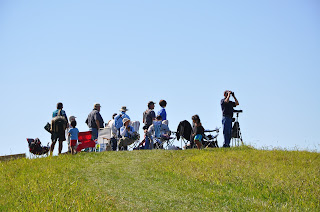 |
| Birders gathered on top of Butterfly Hill for Cantigny's inaugural "Big Sit" in 2019. The group tallied 43 species without leaving their perch, the highest point on the property. |
(published 9-7-21)
There are many ways to birdwatch, making the hobby accessible for just about everybody. It’s one of the best things about birding—you can do it anywhere, at any time.
I treasure the time on my patio, watching and listening
for whatever comes by. Migrating common nighthawks in the evening grabbed my
attention in recent weeks. Now I’m back on morning call, searching for fall
warblers.
Traditional bird walks are fine—I eagerly attend
them and sometimes lead them. But observing birds from a single position can be
equally rewarding and fun.
Two years ago, in partnership with the DuPage
Birding Club, Cantigny Park in Wheaton held its inaugural “Big Sit.” About 30
birders, coming and going throughout a full morning, spotted 43 species from
our lookout atop Butterfly Hill. We had to cancel the 2020 Big Sit but we’re
doing it again on Saturday, Sept. 11. Grab a chair and come on up!
Big Sitting is a thing, trust me. The New Haven Bird
Club in Connecticut came up with the idea in 1993 and even trademarked the
name. Big Sits are now frequently used as fundraisers for bird conservation and
related causes, with donors pledging a certain amount per species. The events
are often a popular sideshow at birding festivals, too.
To be official, a few Big Sit rules apply: the count
must be conducted from within a 17-foot diameter circle, and species must be
identified by the observers over a continuous period, sometimes 24 hours! It’s
a stationary version of a Big Day, but a lot easier on the legs and better for
the environment than driving from place to place.
 |
| Cantigny Park volunteer and DuPage Birding Club member Joan Campbell adds a species to the board during the Big Sit. Butterfly Hill's namesake flower bed is visible in the distance. |
Maximizing a Big Sit count begins with a strategic
location. Cantigny is blessed with an ideal spot, and Butterfly Hill did not even
exist until three years ago. The hill originated from truckloads of displaced
soil during the park’s recent renovation. Hauling the dirt off-site would have
been expensive and wasteful, plus Cantigny wanted to create a scenic overlook.
Park visitors now have a nice view of the Cantigny golf course, not to mention
the giant butterfly-shaped flower bed behind the first green that inspired the
hill’s name.
Most importantly for birdwatchers, the view from
Butterfly Hill features multiple habitats, including grassland, scrub, oak
savannah, pond, and wetland. Birders are nearly eye-level with the crowns of
mature oaks behind the First Division Museum. And of course, open sky—critical
for spotting all manner of fly-bys, from hummingbirds to turkey vultures.
Stationary birding naturally appeals to birders with
limited mobility, and to people who just prefer a less vigorous birding
experience in a social setting. So, in addition to Big Sits, there are little
sits. The DuPage Birding Club this year supplemented its already robust field
trip schedule with “bird sits” at venues around the county. These are two-hour
BYOC (bring your own chair) outings, currently limited to 10 participants, and
non-club members are welcome. You can find out more at dupagebirding.org.
Highly specialized watch parties are out there too,
and good seats are available! In 2018, I wrote about Kane County Audubon’s
annual Chimney Swift Sit. I’ll never forget watching 2,000 chimney swifts swirl
into their nighttime roost, a smokestack at Abbott Middle School in Elgin. The
mesmerizing process began at dusk before several dozen birders in folding
chairs. Curious neighbors came out to see what we were watching. When the last
bird dropped into the old pipe about 20 minutes later, we clapped as if we’d
just witnessed the best fireworks show ever.
 |
| In August, Cantigny hosted its first "Birdability" walk for people with mobility limitations. |
The sedentary events I’ve described are for all birders, but they also fill a niche within a growing movement called Birdability, which strives to make birding and nature more accessible. Virginia Rose, a wheelchair-bound dynamo from Austin, Texas, is Birdability’s founder and head cheerleader. She’s all about creating no-barriers, away-from-home birding opportunities for people with disabilities (birdability.org).
As I read several inspiring stories about Virginia,
it occurred to me that Cantigny would score high on the Birdability scale. The
park offers wide, hard-surface pathways with gentle grades; ramps; and ample
seating in the gardens. Wheelchairs and binoculars are available for borrowing.
In August, we dipped our toes in the water, hosting
a small group of limited-mobility birders for two hours of slow and easy
birding. We spotted 18 species in the gardens near the Visitors Center. The participants
appreciated a walk tailored to their needs—topped by a dazzling Baltimore
oriole that appeared just before we disbanded.
Cantigny is making Birdability walks a regular part
of its birding program. The next outing is on September 24. For more
information, visit Cantigny.org.
Copyright 2021 by Jeff Reiter. All rights reserved.